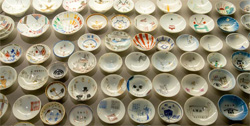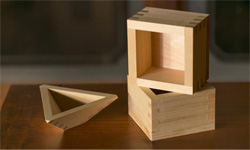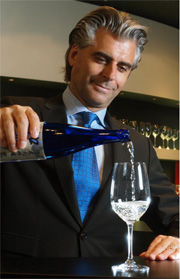Home > Highlighting JAPAN > Highlighting Japan SEPTEMBER 2012 > Cups for All Occasions
Highlighting JAPAN
COVER STORY: Kampai!—A Guide to Japanese Alcoholic Beverages
Cups for All Occasions
A variety of cups are used to drink sake, and each kind has its own long history and cultural background. A number of cups with unconventional designs have been produced in recent years too. Here, we look at some of the variety of cups available to the sake lover.

Sakazuki, a few centimeter in diameter, made in the mid Meiji period and featuring painted flowers and grass
Credit: TADASHI AIZAWA
Tajimi City, Gifu Prefecture, is a major production area of the ceramic known as Minoyaki or Mino Ware. In particular, the Ichinokura area that is located in the most southern part of the city has long been widely known as a major production area for sakazuki (ceremonial sake cups). During the Meiji period (1868–1912), Ichinokura accounted for much of the production of sakazuki nationwide, and it remains today a major producer of ceramics, including sakazuki. The Ichinokura Sakazuki Art Museum opened in 2002 in Ichinokura, as part of the initiatives taken by the local community to revitalize the area.
Approximately 1,500 sakazuki, produced from the end of the Edo period (1603–1867) through the Meiji period to the Showa period (1926–1989) in the Sakazuki Gallery are presented on the first floor of the museum. On the second floor, the Kyoshokan Hall displays approximately forty masterpieces produced by eight living national treasures and great masters associated with the local area.
Yuko Imagawa, general manager of the museum, says, "Among many sakazuki presented in this museum, the most spectacular are those made in the mid Meiji period. Sakazuki made in this period have a thickness of 1 mm that is almost transparent, and they are painted finely, just like miniatures. Literally, they are the work of masters."
Each sakazuki is usually 6 cm in diameter. Although noticeably small among dishes for food and drink, sakazuki have a presence. Imagawa explains, "For a long time in Japan, Japanese sake has been served during religious events and rites. In these events, sakazuki have been highly valued and loved as a dish that serves as an intermediary between human beings and god, and between fellow human beings. Drinking with sakazuki deepens friendships and forms agreements without the need for a written contract."
Ichinokura is also vigorously developing new types of sake cups. In 2006, craftsmen in three ceramic production areas of Tajimi, including Ichinokura, started to develop a new brand of Minoyaki sake cups in cooperation with local governments and academic organizations. In 2011, they developed Mino-tosui Kakutokuri, a local sake of Tajimi that was sold in a Minoyaki sake bottle sold with a wooden sake drinking masu box made in Ogaki City, Gifu Prefecture. This product received the France prize, one of the International Prizes at the Charming Japanese Souvenir Contests 2012, which was sponsored by the Japan Tourism Agency.

Conventional masu (right) and Suichoko (10.8 cm x 9.5 cm x 3.7 cm)
Credit: MASATOSHI SAKAMOTO
A masu, or a wooden drinking box, is a cup for drinking sake, which is as popular as a sakazuki, and it is often use in the toast in a ceremony. The masu was originally developed 1,300 years ago as a container to measure the quantity of rice and other crops and liquid products, such as soy sauce. The masu is made of wood and is square shaped. The history of the masu as a sake cup, which is made of hinoki, or Japanese cypress, and other wood, is surprisingly short: it was only in 1966 when the masu became popular. In 1966, following the revision of the Measurement Act, the inspection of all masu boxes (a stringent inspection of the accuracy of the masu as a scale) was no longer required. As a result, the cost of producing masu boxes declined, and demand for masu boxes as a sake drinking cup surged.
At present, five companies in Ogaki City, Gifu Prefecture, near the plantation sites of hinoki, manufacture 80% of the masu produced nationwide. Ohashi Ryoki is one of these five companies and is well known for its development of unique products that change the common concept of a masu.
Hiroyuki Ohashi, president of Ohashi Ryoki, explains, "The masu is very suitable for drinking Japanese sake because of the smell of hinoki, the wooden material for masu boxes. The appearance of the masu with sake poured into it is also very appealing."
Because Ohashi Ryoki has an English website to promote its masu, it often receives overseas orders, especially from the United States. Many of these orders are from Japanese restaurants overseas, but Ohashi Ryoki once received requests for as many as 2,000 masu boxes from a clock shop in New York that was going to use masu boxes for packaging watches.
In 2010, Ohashi Ryoki started selling Suichoko, a masu that had a shape totally unlike conventional models. A triangular masu made of three triangles, it won the 2011 Good Design Award for its unconventional design.
Says Ohashi, "I wanted to dispel the fixed notion of the masu being a square shape. When drinking sake with Suichoko, because it has sharp corners, sake comes to the mouth in the form of a thin line. So customers are happy with its unique appearance and its convenient design for actual drinking."

Wolfgang J. Angyal, president of Riedel Japan, filling Japanese sake in the Daiginjo glass
Credit: TADASHI AIZAWA
People in Japan generally drink sake with a sakazuki or a masu. In 2000, Riedel, a prestigious wine glass manufacturer with a history of over 250 years in Austria, introduced the Daiginjo glass, for use in tasting daiginjoshu (a luxury sake with a sophisticated fragrance, made from rice polished to at least 50% its original size). The Daiginjo glass does not look any different from ordinary wine glasses. However, when tasting daiginjoshu, the glass is able to bring out the deep taste and rich fragrance unique to daiginjoshu.
The making of Daiginjo glasses started in 1998 when Fukumitsuya (see page 15), a venerable sake maker in Kanazawa City, Ishikawa Prefecture, asked Riedel to develop a glass that was specially designed to properly bring out the supreme taste of Japanese sake. In response, Riedel produced sixty types of sample glasses for Daiginjoshu, and held twenty-five screening meetings (workshops) to select and determine the shape of the glass that was most suitable for Daiginjoshu, working together with the representatives of sake makers and experts. After these meetings, the choice of glasses was narrowed down to six. The final screening meeting (official workshop) was held at the Austrian Embassy with twelve sake makers, where one particular glass received an overwhelming evaluation and was chosen to become Riedel's official Daiginjo glass.
According to Wolfgang J. Angyal, president of Riedel Japan, "When you drink daiginjoshu with this glass, make sure not to pour more than one third of a glass full." He continues, "When only a little sake is used, there will be more space in the glass to maintain the fragrance. This will enable you to enjoy the rich fragrance of daiginjoshu. The angle of the glass when it is brought to the mouth is also very important. The Daiginjo glass is designed to produce the best balance of the sweetness and the acidity of daiginjoshu when the glass is tilted towards the mouth in a natural manner."
Sales of the Daiginjo glass, an original product of Riedel, have also been growing steadily in the United States and Europe, on the strength of the boom in popularity of Japanese foods overseas.
© 2009 Cabinet Office, Government of Japan






